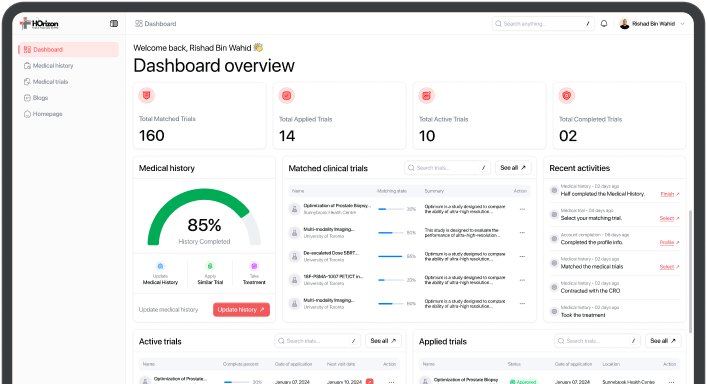Study of Magrolimab Given Together With FOLFIRI/BEV in Patients With Previously Treated Advanced Inoperable Metastatic Colorectal Cancer (mCRC) (ELEVATE CRC)
Contact information
Gilead Clinical Study Information Center
Princess Margaret Cancer Centre
Toronto, Canada, M5G 1X6
Basic information
N/A
N/A Age
135 Enrollment
Trial Details
Brief Summary
The goals of this clinical study are to learn more about the safety, tolerability and effectiveness of magrolimab in combination with bevacizumab and 5-fluorouracil, irinotecan, and leucovorin (FOLFIRI) in previously treated participants with advanced inoperable metastatic colorectal cancer (mCRC). The primary objectives of this study are: (safety run-in cohort) to evaluate safety and tolerability, and the recommended Phase 2 dose (RP2D) and (randomized cohort) to evaluate the efficacy of magrolimab in combination with bevacizumab and 5-fluorouracil, irinotecan, and leucovorin (FOLFIRI) in previously treated participants with advanced inoperable metastatic colorectal cancer (mCRC).
Official Title
A Phase 2, Randomized, Open-Label Study Evaluating the Safety and Efficacy of Magrolimab in Combination With Bevacizumab and FOLFIRI Versus Bevacizumab and FOLFIRI in Previously Treated Advanced Inoperable Metastatic Colorectal Cancer (mCRC)
Selection Criteria
Eligibility Inclusion Criteria
-
- Previously treated individuals with inoperable metastatic colorectal cancer (mCRC) who are ineligible for checkpoint inhibitor therapy (microsatellite instability (MSI)-H or mismatch repair deficient (dMMR) and are excluded).
- Histologically or cytologically confirmed adenocarcinoma originating in the colon or rectum (excluding appendiceal and anal canal cancers) who have progressed on or after 1 prior systemic therapy in the setting where curative resection is not indicated. This therapy must have included chemotherapy based on 5-FU or capecitabine with oxaliplatin and either bevacizumab, or for patients with RAS wild-type and left-sided tumors, bevacizumab, cetuximab, or panitumumab.
- Measurable disease (RECIST V1.1 criteria).
- Individuals must have an eastern cooperative oncology group (ECOG) performance status of 0 or 1.
- Life expectancy of at least 12 weeks.
- Laboratory measurements, blood counts: adequate hemoglobin, neutrophil, and platelet counts
- Adequate liver function.
- Adequate renal function.
Eligibility Exclusion Criteria
-
- Prior anticancer therapy including chemotherapy, hormonal therapy, or investigational agents within 3 weeks or within at least 4 half-lives prior to magrolimab dosing (up to a maximum of 4 weeks), whichever is shorter.
- Known v-raf murine sarcoma viral oncogene homolog B1 (BRAF) V600E or MSI-H mutations or dMMR.
- Persistent Grade 2 or more gastrointestinal bleeding.
- Individuals with prior irinotecan therapy.
- Clinically significant coronary artery disease or myocardial infarction within 6 months prior to inclusion.
- Peripheral neuropathy of more than Grade 2 (CTCAE Version 5.0).
- Known dihydropyrimidine dehydrogenase deficiency.
- Acute intestinal obstruction or subobstruction, history of inflammatory intestinal disease or extended resection of the small intestine. Presence of a colonic prosthesis.
- Unhealed wound, active gastric or duodenal ulcer, or bone fracture.
- History of abdominal fistulas, trachea-oesophageal fistulas, any other Grade 4 gastrointestinal perforations, nongastrointestinal fistulas, or intra-abdominal abscesses 6 months prior to screening.
- Uncontrolled arterial hypertension.
- Thromboembolic event in the 6 months before inclusion (eg, transitory ischemic stroke, stroke, subarachnoid hemorrhage) except peripheral deep vein thrombosis treated with anticoagulants.
- Active central nervous system (CNS) disease. Individuals with asymptomatic and stable, treated CNS lesions (radiation and/or surgery and/or other CNS-directed therapy who have not received corticosteroids for at least 4 weeks) are allowed.
- Red blood cell (RBC) transfusion dependence, defined as requiring more than 2 units of packed RBC transfusions during the 4-week period prior to screening.
- History of hemolytic anemia, autoimmune thrombocytopenia, or Evans syndrome in the last 3 months.
- Known hypersensitivity to any of the study drugs, the metabolites, or formulation excipient.
- Known inherited or acquired bleeding disorders.
- Significant disease or medical conditions, as assessed by the investigator and sponsor, that would substantially increase the risk-benefit ratio of participating in the study.
- Second malignancy, except treated basal cell or localized squamous skin carcinomas, or localized prostate cancer.
- Uncontrolled pleural effusion.
